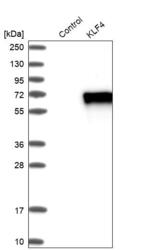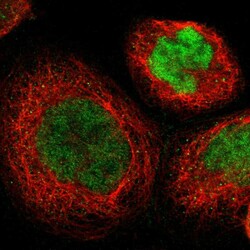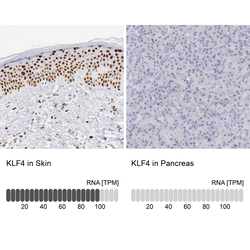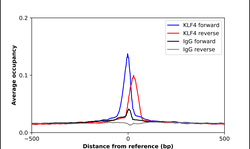Antibody data
- Antibody Data
- Antigen structure
- References [13]
- Comments [0]
- Validations
- Western blot [1]
- Immunocytochemistry [1]
- Immunohistochemistry [1]
- Chromatin Immunoprecipitation [1]
Submit
Validation data
Reference
Comment
Report error
- Product number
- HPA002926 - Provider product page

- Provider
- Atlas Antibodies
- Proper citation
- Atlas Antibodies Cat#HPA002926, RRID:AB_1852541
- Product name
- Anti-KLF4
- Antibody type
- Polyclonal
- Description
- Polyclonal Antibody against Human KLF4, Gene description: Kruppel-like factor 4 (gut), Alternative Gene Names: EZF, GKLF, Validated applications: IHC, WB, ICC, ChIP, Uniprot ID: O43474, Storage: Store at +4°C for short term storage. Long time storage is recommended at -20°C.
- Reactivity
- Human
- Host
- Rabbit
- Conjugate
- Unconjugated
- Isotype
- IgG
- Vial size
- 100 µl
- Concentration
- 0.2 mg/ml
- Storage
- Store at +4°C for short term storage. Long time storage is recommended at -20°C.
- Handling
- The antibody solution should be gently mixed before use.
Submitted references KLF4 Suppresses the Progression of Hepatocellular Carcinoma by Reducing Tumor ATP Synthesis through Targeting the Mir-206/RICTOR Axis
Retinoblastoma Protein Is Required for Epstein-Barr Virus Replication in Differentiated Epithelia
Microenvironmental and cell intrinsic factors governing human cDC2 differentiation and monocyte reprogramming
Stemness and clinical features in relation to the subventricular zone in diffuse lower-grade glioma: an exploratory study.
Cell-fate transition and determination analysis of mouse male germ cells throughout development
Inhibition of Epstein-Barr Virus Replication in Human Papillomavirus-Immortalized Keratinocytes
KLF4-dependent perivascular cell plasticity mediates pre-metastatic niche formation and metastasis
BMP signaling orchestrates a transcriptional network to control the fate of mesenchymal stem cells in mice
Tankyrase inhibition promotes a stable human naïve pluripotent state with improved functionality
Differentiation-Dependent KLF4 Expression Promotes Lytic Epstein-Barr Virus Infection in Epithelial Cells
Endothelial Krüppel-like Factor 4 Regulates Angiogenesis and the Notch Signaling Pathway
ZNF750 interacts with KLF4 and RCOR1, KDM1A, and CTBP1/2 chromatin regulators to repress epidermal progenitor genes and induce differentiation genes
A study of embryonic stem cell‐related proteins in human astrocytomas: Identification of Nanog as a predictor of survival
Wang Y, Zuo D, Huang Z, Qiu Y, Wu Z, Liu S, Zeng Y, Qiu Z, He W, Li B, Yuan Y, Niu Y, Qiu J
International Journal of Molecular Sciences 2024;25(13):7165
International Journal of Molecular Sciences 2024;25(13):7165
Retinoblastoma Protein Is Required for Epstein-Barr Virus Replication in Differentiated Epithelia
Myers J, Schaal D, Nkadi E, Ward B, Bienkowska-Haba M, Sapp M, Bodily J, Scott R, Banks L
Journal of Virology 2023;97(2)
Journal of Virology 2023;97(2)
Microenvironmental and cell intrinsic factors governing human cDC2 differentiation and monocyte reprogramming
Lang M, Krump C, Meshcheryakova A, Tam-Amersdorfer C, Schwarzenberger E, Passegger C, Connolly S, Mechtcheriakova D, Strobl H
Frontiers in Immunology 2023;14
Frontiers in Immunology 2023;14
Stemness and clinical features in relation to the subventricular zone in diffuse lower-grade glioma: an exploratory study.
Corell A, Gómez Vecchio T, Ferreyra Vega S, Dénes A, Neimantaite A, Hagerius A, Barchéus H, Solheim O, Lindskog C, Bontell TO, Carén H, Jakola AS, Smits A
Neuro-oncology advances 2022 Jan-Dec;4(1):vdac074
Neuro-oncology advances 2022 Jan-Dec;4(1):vdac074
Cell-fate transition and determination analysis of mouse male germ cells throughout development
Zhao J, Lu P, Wan C, Huang Y, Cui M, Yang X, Hu Y, Zheng Y, Dong J, Wang M, Zhang S, Liu Z, Bian S, Wang X, Wang R, Ren S, Wang D, Yao Z, Chang G, Tang F, Zhao X
Nature Communications 2021;12(1)
Nature Communications 2021;12(1)
Inhibition of Epstein-Barr Virus Replication in Human Papillomavirus-Immortalized Keratinocytes
Guidry J, Myers J, Bienkowska-Haba M, Songock W, Ma X, Shi M, Nathan C, Bodily J, Sapp M, Scott R, Longnecker R
Journal of Virology 2019;93(2)
Journal of Virology 2019;93(2)
KLF4-dependent perivascular cell plasticity mediates pre-metastatic niche formation and metastasis
Murgai M, Ju W, Eason M, Kline J, Beury D, Kaczanowska S, Miettinen M, Kruhlak M, Lei H, Shern J, Cherepanova O, Owens G, Kaplan R
Nature Medicine 2017;23(10):1176-1190
Nature Medicine 2017;23(10):1176-1190
BMP signaling orchestrates a transcriptional network to control the fate of mesenchymal stem cells in mice
Feng J, Jing J, Li J, Zhao H, Punj V, Zhang T, Xu J, Chai Y
Development 2017;144(14):2560-2569
Development 2017;144(14):2560-2569
Tankyrase inhibition promotes a stable human naïve pluripotent state with improved functionality
Zimmerlin L, Park T, Huo J, Verma K, Pather S, Talbot C, Agarwal J, Steppan D, Zhang Y, Considine M, Guo H, Zhong X, Gutierrez C, Cope L, Canto-Soler M, Friedman A, Baylin S, Zambidis E
Development 2016;143(23):4368-4380
Development 2016;143(23):4368-4380
Differentiation-Dependent KLF4 Expression Promotes Lytic Epstein-Barr Virus Infection in Epithelial Cells
Speck S, Nawandar D, Wang A, Makielski K, Lee D, Ma S, Barlow E, Reusch J, Jiang R, Wille C, Greenspan D, Greenspan J, Mertz J, Hutt-Fletcher L, Johannsen E, Lambert P, Kenney S
PLOS Pathogens 2015;11(10):e1005195
PLOS Pathogens 2015;11(10):e1005195
Endothelial Krüppel-like Factor 4 Regulates Angiogenesis and the Notch Signaling Pathway
Hale A, Tian H, Anih E, Recio F, Shatat M, Johnson T, Liao X, Ramirez-Bergeron D, Proweller A, Ishikawa M, Hamik A
Journal of Biological Chemistry 2014;289(17):12016-12028
Journal of Biological Chemistry 2014;289(17):12016-12028
ZNF750 interacts with KLF4 and RCOR1, KDM1A, and CTBP1/2 chromatin regulators to repress epidermal progenitor genes and induce differentiation genes
Boxer L, Barajas B, Tao S, Zhang J, Khavari P
Genes & Development 2014;28(18):2013-2026
Genes & Development 2014;28(18):2013-2026
A study of embryonic stem cell‐related proteins in human astrocytomas: Identification of Nanog as a predictor of survival
Elsir T, Edqvist P, Carlson J, Ribom D, Bergqvist M, Ekman S, Popova S, Alafuzoff I, Ponten F, Nistér M, Smits A
International Journal of Cancer 2013;134(5):1123-1131
International Journal of Cancer 2013;134(5):1123-1131
No comments: Submit comment
Enhanced validation
- Submitted by
- Atlas Antibodies (provider)
- Enhanced method
- Recombinant expression validation
- Main image

- Experimental details
- Western blot analysis in control (vector only transfected HEK293T lysate) and KLF4 over-expression lysate (Co-expressed with a C-terminal myc-DDK tag (~3.1 kDa) in mammalian HEK293T cells, LY401356).
- Sample type
- Human
- Protocol
- Protocol
Supportive validation
- Submitted by
- Atlas Antibodies (provider)
- Main image

- Experimental details
- Immunofluorescent staining of human cell line A-431 shows localization to nucleoplasm.
- Sample type
- Human
Supportive validation
- Submitted by
- Atlas Antibodies (provider)
- Enhanced method
- Orthogonal validation
- Main image

- Experimental details
- Immunohistochemistry analysis in human skin and pancreas tissues using HPA002926 antibody. Corresponding KLF4 RNA-seq data are presented for the same tissues.
- Sample type
- Human
- Protocol
- Protocol
Supportive validation
- Submitted by
- Atlas Antibodies (provider)
- Main image

- Experimental details
- ChIP-Exo-Seq composite graph for Anti-KLF4 (HPA002926, Lot 000008245) tested in NCCIT cells. Strand-specific reads (blue: forward, red: reverse) and IgG controls (black: forward, grey: reverse) are plotted against the distance from a composite set of reference binding sites. The antibody exhibits robust target enrichment compared to a non-specific IgG control and precisely reveals its structural organization around the binding site. Data generated by Prof. B. F. Pugh´s Lab at Cornell University.
 Explore
Explore Validate
Validate Learn
Learn Western blot
Western blot Immunocytochemistry
Immunocytochemistry